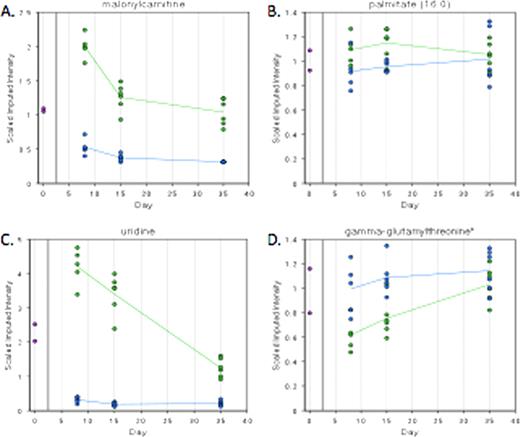Abstract
Abstract 2035
Red cell lifespan follows a well-defined, species-specific trajectory approaching 120 days in humans and 50 days in the mouse. At the end of this period, ‘senescent’ red cells are removed from the circulation by phagocytes, upon recognition of a surface change, or changes in the physical properties of the aged RBC. Because mature red cells have no capacity for synthesis of new proteins, and have little ability to repair damage—limitations on red cell survival are likely to relate to functional decline secondary to accumulation of damage to cell constituents. Among key targets are glycolytic enzymes, proteins involved in redox metabolism, and structural proteins, as inherited defects in these proteins can shorten red cell survival and cause hemolytic anemia. In order to further evaluate metabolic changes in normal RBC over the course of RBC lifespan, we used an in vivo biotinylation method followed by magnetic bead separation to isolate murine red cells of defined age at intervals. Purified RBC were assessed for protein oxidation, reactive oxygen species production, surface antigen profile, and the abundance of metabolic intermediates using a multiplatform mass spectrometry approach. 167 metabolites were detected in RBC extracts collected at 8, 15 and 35 days after labeling, using 6 biologic replicates for each time point. Multiple metabolites showed statistically significant changes in abundance as a function of red cell age. The figure below presents representative examples of patterns of change observed—where each line corresponds to either the biotin – (younger) or the biotin + (older) fraction. Panel A was the most common pattern observed—where a steep initial decline indicates a metabolite that may be specific for reticulocytes, found at high concentration only in the youngest cell fraction. Panel B indicates a metabolite that didn't change, panel C is an example of a metabolite with a more linear pattern of decay, and panel D is an example of a metabolite that increased with increasing red cell age. Older cells had higher levels of glucose, and lower levels of downstream metabolites from both the glycolytic and pentose phosphate pathways—consistent with a decline in hexokinase activity when comparing young and old red cells. Older cells had evidence of cumulative oxidative damage as demonstrated by increased protein carbonyl content, and had higher levels of reactive oxygen species. Surprisingly, despite this evidence of oxidative stress, reduced glutathione levels increased with cell age, and content of oxidized glutathione was unchanged. However, accumulation of alternate products of red cell gamma glutamylcysteine synthetase suggests substrate deprivation. The pattern of glutathione-related metabolites we observed in aged red cells has been described in tissues subjected to acute oxidant stress. The observed changes in metabolite concentrations support the hypothesis that metabolic decline during red cell aging impairs energy production, generation of reducing equivalents, and capacity to reverse protein oxidation. How (or whether) these changes in metabolic equilibrium are converted into a signal that results in removal of senescent red cells from the circulation remains speculative. However, we observe red cell age-dependent changes in additional metabolites, including specific lipids, that may help to bridge this gap in understanding.
No relevant conflicts of interest to declare.
Author notes
Asterisk with author names denotes non-ASH members.


